The Composition of the Teutonic Order
The Universal Leadership
Generalkapitel
The Generalkapitel (general chapter) was the collection of all
the
priests, knights and halfbrothers (German: "Halbbrüder"). Because
of the logistical problems
to assemble the members, who were spread
over large distances, only deputations of the Balleien and Kommenden
gathered to form the Generalkapitel. The Generalkapitel was designed
to meet once in a year, but the conventions usually
were limited to
the election of a new Hochmeister. The decisions of the Generalkapitel
had a binding effect on
the Großgebietigers of the order.

Hochmeister
The Hochmeister (grand master) was the highest officer of the order.
Until 1525, he was elected by the Generalkapitel. He had the rank of
an ecclastic emperial state and was sovereign
prince of Prussia until
1466. Despite this high formal position, practically, he only was a
kind of first among
equals.

Großgebietiger
The Großgebietiger were high officers with competence on
the whole
Teutonic Order, appointed by the Hochmeister. There were five offices.
* The Großkomtur...(Magnus Commendator),
the deputy of the Hochmeister
* The Treßler.............................the
treasurer
* The Spitler...........(Summus
Hospitalarius),
responsible for all hospital affairs
* The Trapier...............................responsible
for dressing and armament
* The Marschall........(Summus Marescalcus),
the chief of military affairs.

The National Leadership
of the Order - Landmeister
The order was divided in three national chapters, Prussia, Livland
and the territory of the Holy Roman Empire
Highest officer of each
chapter was the Landmeister (country master). They were elected by
the regional chapters.
In the beginning, they were only substitutes
of the Hochmaster but were able to create a power of their own.
Within
their territory, the Hochmeister could not decide against
their will. In the end of the rule over Prussia, factual,
the
Hochmeister only was Landmeister of Prussia. There were three

Landmeister
* The Landmeister in Livlan.....................the successor of the Herrenmeister
(lords master) of the former Livonian Brothers of the Sword
* The Landmeister of Prussia.......................since 1309 united with the office
of the Hochmeister, who
was situated in Prussia since then.
* The Deutschmeister.....the Landsmeister of the Holy Empire. When Prussia
and
Livland were lost, the Deutschmeister also became Hochmeister.

The Regional Leadership of the Order
Because the properties of the order within the rule of the Deutschmeister
did not form a cohesive territory but were spread over the whole empire
and parts
of Europe, there was an additional regional structure, the Ballei.
Kammerbaleien were governed by the Hochmeister himself.
Some of these
Baleis had the rank of imperial states
* Deutschordensballei Thuringia.................................................(Zwätzen)
* Deutschordensballei.........................................................Hesse
Marburg)
* Deutschordensballei......................................................Saxonia Lucklum)
* Brandenburg..............................................................................................
* Deutschordensballei.........Westfalia (Deutschordenskommende Mülheim)
* Deutschordensballei...................................................Franconia
(Ellingen)
* Kammerballei.................................................................................Koblenz
* Deutschordensballei..........................Schwabia-Alsace-Burgundy (Rufach)
* Deutschordensballe.........Etsch
and in the Mountains (south tyrol) (Bozen)
* Utrecht........................................................................................................
* Lorraine............................................................................................(Trier)
* Kammerballei..................................................................................Austria
* Deutschordensballei................................................................Alden
Biesen
* Sicily............................................................................................................
* Deutschordensballei..............................................................San Leonardo)
* Lombardy...............................................................(also
called Lamparten)
* Kammerballei................................................................................Bohemia
* Deutschordensballei...........................................Romania (Achaia, Greece)
* Armenien-Zyprus.........................................................................................

The Local Leadership of the Order - Komtur
The smallest administrative
unit of the order was the Kommende.
It was ruled by a Komtur, who had all administrative rights and
controlled
the vogteien (district of a reeve) and Zehnthöfe (tithe
collectors) within his rule. In the Kommende, all kinds
of brothers
lived together in a monastical way. Noblemen served as Knightbrothers
or Priestbrothers. Other people
could serve as Sariantbrothers, who
were armed soldiers and as Halfbrothers, who were working in economy
and healthcare.

The Special Offices
of The Order
* The Kanzler........(chancler)
of the Hochmeister and the Deutschmeister. The chancellor
took care of the keys and seals of the Order and was recording
clerk of the kapitel.
* The Münzmeister
...............(master of the mint)of Thorn. In 1246 the order received the
right to produce its own coins the Moneta
Dominorum Prussiae - Schillingen.
* The Pfundmeister.......(customs
master) of Danzig. The Pfund was a local customs duty.
* The Generalprokurator............................the representant of the order at the holy seat.
* The Großschäffer.....................................a
trading representant with special aithority.
The Orders Brethren
Some of the Brethren formed the Military wing of the Order. There
were
three distinct groups of Brethren, the RitterBrudern, the Diendebrudern
and the HalbBrudern. Under the Statutes
of the Order anyone wishing to
join the Order had to speak German and not as is often portrayed be German.
There
were further restrictions on what capacity a new member could serve.
The RitterBrudern and HalbBrudern had to be from
a Noble family, while the
Diendebrudern was open to anyone of military experience. The above combined
with the requirement
to take monastic vows limited the numbers of Brethren
in the Order.
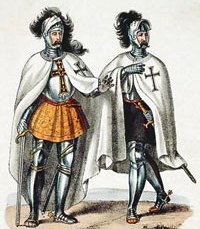
The RitterBrudern - Brother Knight
These monastic Knights were the Elite of the Order. Their equipment
was the
best available of the time comparable with that of the best Knights of Western
Europe. A White Jupon marked
with a black cross distinguished the RitterBrudern
from other troops in the Order's forces. The number of RitterBrudern
peaked in
the period just prior to the battle of Tannenberg. The highest figure given by
Historians is around
750 though the more accepted figure is around 500. Order
records put the loss of RitterBrudern at Tannenberg as 203(out
of the 250 present).
The loss of between a third and a half of their total numbers was in itself a
disaster but
this number included almost every senior officer of the Order.
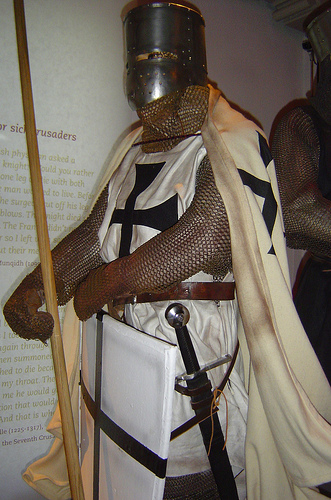
The DiendeBrudern
These Brothers were those not of Noble birth. Their military role
was either as
lesser men at arms forming the rear ranks to the RitterBrudern and HalbBrudern or
as infantry. Their
infantry role was usually that of an officer commanding non-
Brethren foot. The closest equivalent would be that of an
NCO in modern armies as
usually a Lay or Brethren Knight had overall command. The Diendebrudern wore a
light grey
Jupon with a tau cross. A Tau cross is the shape of a capital T.
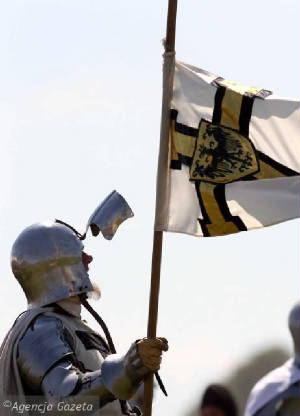
The HalbBrudern - Half Brothers
These were members of the Order but whose period of service and
duties were less
than the RitterBrudern or DiendeBrudern. Unlike these Brethren the HalbBrudern
did not take monastic
vows of service for life. These Half Brothers may well have
been an attempt to encourage people unwilling to join the
Order for life or those
fulfilling lesser Crusader vows. The HalbBrudern wore a light grey Jupon with a
tau cross.
Unlike other Brethren of the Order it appears that the HalbBrudern were
allowed to combine their family coats of arms
with that of the Tau Cross. This
may explain why examples of such have been found even though the Statutes of the
Order expressly forbid such practises. That said even some Hochmeisters quartered
their coats of arms with the Order's
Cross.
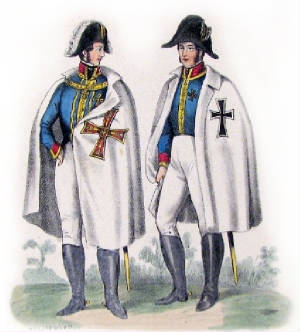
The Other forces of the Order
The Brethren of the Order formed a very small proportion of available
troops. The majority were supplied vassals, the rest by volunteers.

The Vassals
There was no uniform law on vassalage within the Order controlled
lands.
The Germanised areas fell under the equivalents of Imperial law on the
subject, all of Prussia being technically
a Imperial Fief held by the
Order. Conquered Polish and Lithuanian lands appear to have followed Polish
precedent
on vassal service. Running alongside these was vassalage in the
'Prussian fashion' this only applied to the natives
or non-nobles in the
case of Polish and Lithuanian lands. German and Polish vassalage differed
only in the details
so is not covered separately.

The MitBrudern - Lay Knights
Nobility that held land granted to them by the Order. These Nobles were
almost always German though some of
the border families were Polish in
origin. As with much of Europe the holding of land imposed certain duties
on
the holder. In the case of land granted by the Order the amount defined
the service. A surviving Order document relating
to land holdings in Chelmno,
dated 1223 provides information on two main types of service, The Rossdienst
and the
Platendienst. The Rossdienst was anyone holding over 40 Ian (also
called a Hufen) was expected to muster a horseman
in full armour with a barded
steed along with two retainers, this forming the traditional German Lance.
Note the
barded steed may well be a mistranslation and in fact may merely mean
a horse in a cloth housing. The Platendienst was
anyone holding fewer than 40
Ian and usually refereed to native Prussians who was expected to muster in
lesser
armour and be mounted. Later Order documents show a reduction in the
minimum, some as low as 15 Ian for Rossdienst.
However these reductions appear
in areas long pacified by the Order. There are two probable reasons for this.
Firstly
that these 'secure' areas were more effectively farmed/managed and so
provided greater wealth. Secondly by the late 14th
Century the Order was
increasingly allowing vassals to buy their way out of military service so a
downward trend
in the minimum Ian would have increased revenues.
Certainly frontier estates retained larger minima.

The Volunteers - Crusaders and Adventurers
Prior to 1400 the Order was able to recruit large numbers of volunteers
for its
campaigns. These volunteers were mostly German however some Grandees of European
Nobility also took part.
Henry Bolingbroke (later Henry IV) of England for instance
campaigned twice in Prussia in the 1390's. These volunteers
served for a variety
of reasons, some to fulfil crusading vows, others for prestige and many for loot.

The German Colonists
From its earliest conquests in the Baltic the Order encouraged
German Colonists to
settle in the new territories. This created numerous 'German' Towns and villages.
As a result
by the late 14th Century the Order was able to call upon quite
significant Militias from these towns and villages. These
Militias did take to the
field though their usefulness was as suspect as their German counterparts, their
primary
function was defence of their town. The Richer Burghers of the towns were
able to buy their way out of field service
by supplying a mercenary replacement.
This was either a mounted Knight or a foot soldier depending on their wealth.

The Native Troops of the Teutonic
Order
The Order recruited large numbers of native troops to serve with their armies.
These
contingents were invariably lightly equipped and the least effective of
the Order's soldiers. They were however abundant
and provided the bulk of the
army and as often as not took the brunt of the casualties as well. The quality
of
these troops was also highly variable. The Border provinces of the Livonian
territories provided an enthusiastic levy
for the Order as they were usually
employed to fight their traditional enemies the Estonians.
The long held Prussian Provinces tended to provide the least effective levy,
presumably
as their fighting spirit had long been crushed by Order control.
It was the provinces that bordered Lithuania and Poland
that produced the best
native troops and also the most revolts. Overall the best were the light horse
who were usually
recruited under the Platendienst, these forming contingents
known as Turkopolen. The levy foot were usually bow or spear
armed and carried
a shield. They however faired badly in European style warfare, these native
foot may well have
formed the majority of the infantry ridden down by the
Lithuanians at the start of the battle of Tannenberg. That said
the lightness
of the native foot made them highly useful for the more normal raid and counter
raid that distinguishes
much of the Order's frontier wars of the period.
They were far more effective in the woods and marshes of Lithuania
than
the heavily armoured mercenary infantry and Knights of the Order.

The Orders Mercenaries
The Order used mercenaries to bolster its forces, particularly
as more
vassals bought their way out of military service. These mercenaries were
usually German in origin, for
no other reason than the fractured nature
of the Holy Roman Empire created large numbers of these troops. Precise
numbers are not known though the Polish Chronicler Jan Dlugosz states
around 4,000 hired troops were present at Tannenberg
out of some 30,000.
What is not clear is whether Dlugosz is referring to mounted Knights only.
This is probable
as Dlugosz give scant information on the foot of the Order.
Accounts of the Order confirm the approximate numbers of
Dlugosz. They note
1237 Knightly lances were present at the battle of Tannenberg, assuming 3
to lance that gives
a total of 3711 men. These lances were paid 11 marks per
month. To put this in perspective this would buy 8 cows or 400
geese at the
time of Tannenberg.

The Organisation
The basic mounted element of the Order's forces was the Gleve or
Lance,
see Medieval German Pages for more detail ( Feudal Forces). These lances
were grouped together into Banners
which formed the standard combat
units of the army.

The Knightly Banners of the Teutonic
Order
The Knightly banners of the Order army formed the majority of its
forces. These
Banners can be put into three distinct groups, Order
Banners, Vassal Banners and other Banners.

The Teutonic Order Banners
These Knightly Banners varied in size and composition. Normally
a Banner
represented the forces of a Komturei. This would comprise of the Ritter
Brudern, the Diendebrudern, MitBrudern,
HalbBrudern of the Komturei and
all their mounted retainers. Alongside these the Banner could also contain
any
mercenaries hired to replace Burghers of the Towns and those that had
bought themselves out of military service. Separate
Banners could also be
fielded by Bailiwicks, Procuratorships, towns and cities, and even occasionally
Bishoprics.
Though in these cases it was usually only those on frontiers that
were of sufficient size to be able to form their own
Banners. Sometimes several
Komturei or associated divisions would combine to form one Banner fighting under
the
Landmeister of a Province. The very nature of the Order, that of Monastic rules
and Obedience, meant that these Banners
were highly disciplined and accustomed to
obeying orders. These banners were in effect Professional troops and did not
display
the impetuosity and disregard for orders commonly associated with medieval Knights.

The Vassal Banners
This is a bit of a misnomer. These banners were in reality a mix
of Mercenaries,
MitBrudern and small contingents of German volunteers. The majority of these
Banners were either
MitBrudern or Mercenaries. What distinguishes them from the
Banners discussed under 'Other Banners' below is that they
were usually led by a
Brethren Knight, usually a RitterBrudern. Their composition meant that their
effectiveness
was somewhat less that Order banners as they were unaccustomed to
fighting as a cohesive unit. Never the less these
troops were usually disciplined
and well organised.
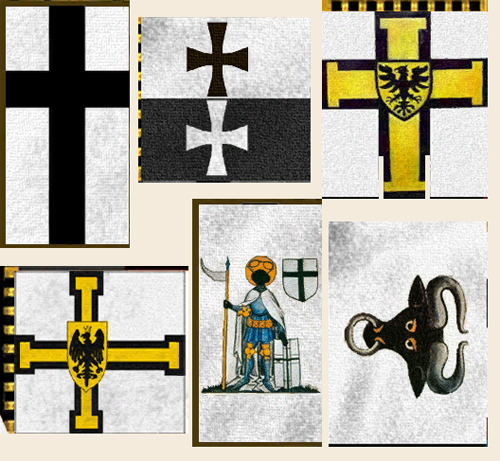
The Other Banners of the Order
A catch all to cover Banners that fell outside the professionalism of the rest
of the Order's forces. This includes
crusading volunteers, Vassals and allies
of the Order who provided sufficiently large forces to insist on personal
control of their troops. The Duke of Stettin, Casmir V, was such an ally.
Stettin was a Polish Dukedom but Casmir
allied with the Order in the late 14th
century and led his forces against Poland at the battle of Tannenberg. The
Crusading volunteers were by the 15th Century almost entirely German in origin.
The Vassals Banners were those not
led by Brethren of the Order. As such all
of these Banners appear to have acted just as impetuously as their Western
Counterparts. What information there is on the Battle of Tannenberg suggests
that it was these Banners that pursued
the Lithuanians too far and were cut
to pieces as a result.
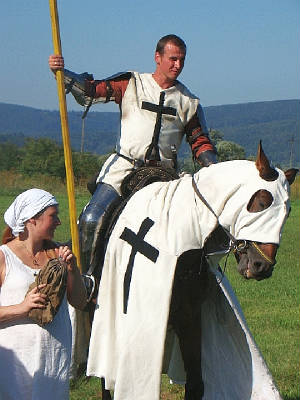
The Orders Light Horse
A mix of native horse and Turkopolen. Unlike their Lithuanian counterparts
the
native horse were skirmishers unlikely to be involved in close combat.
The majority of native light horse was
supplied by the Livonian vassals of the
Order and as such may not have participated in the campaigns against Lithuania.
Required equipment appears only to have been a horse and a bow. The Turkopolen
may have been more capable of engaging
in close combat as they appear to have
been based or at least named from the their original counterparts in the Holy
Land, suggesting a similar role. This implies light armour, lance, bow and
possibly a shield in the fashion of the
Lithuanian Light horse. There is little
evidence for the role of Turkopolen however except that they performed scouting
duties for the Order and were used as a second line in battle. The battle of
Tannenberg sources make no mention of
any pre-battle skirmishing nor of Turkopolen
troops being present. This may mean that these troops were not light horse
as
such but rather lightly equipped retainers intended for combat rather than
skirmishing. It should be pointed
out however that the lack of skirmishing
at Tannenberg may be more to do with the large numbers of Lithuanian light
horse present which would have overwhelmed the Order's light horse.

The Orders Infantry
The
infantry fielded by the Order can be divided into two main groups.

The
Native Levy - Militia
Rarely mentioned
in sources and usually only in terms of the numbers killed or
captured. Organisation was likely to be minimal and their
equipment varied.
As mentioned previously the native levies were of most use in the raiding
carried out by the
Order. There are very few 14th of 15th Century references
to such a levy being used in large scale battles. Jan Dlugosz
makes reference
to 5,000 'Servants' at the battle of Tannenberg and these may well be native
levy and/or ill equipped
Colonist Militia.

The 'Well Armed Men'
The term used by Jan Dlugosz to describe some 6,000 infantry present
at
Tannenberg. They appear to have been a mix of armoured spearmen and
Crossbowmen and were led by Brethren Officers.
These units like their
mounted counterparts were a mix of Mercenaries, Order foot, Vassal foot
and City militias.
They probably differed little from their German
counterparts. Surprisingly they appear to have been swept away by the
first charge at Tannenberg.

The Orders Artillery
The Order was by the 15th Century well equipped with artillery.
These were
however normally confined to siege warfare rather than field battles. Their
appearance in the field only
occurred in large scale campaigns that expected
to fight pitch battles. There were apparently 100 field pieces deployed
at
Tannenberg. Their effect on the battle was exceptionally limited.

The Battle Tactics of the Teutonic Order
These were essentially the same as most Western European armies
of the period.
It placed the emphasis on the shock charge of Knightly banners to break apart
the enemy army. The
disciplined nature of the Order forces did provide them
with some more sophisticated tactical opportunities. The Order
divided its army
into two wings and a centre. What evidence there is for large scale Order battles
suggests that
deployment was initially defensive in nature. Infantry and artillery
would be deployed in front of the mounted. If sufficient
infantry was present this
would cover the entire front (as at Tannenberg) otherwise just the centre.
The infantry and artillery would be used to soften up and break apart attacking
enemy troops and at which point the Mounted Banners would counter charge. In all
cases the Order seems to have made
use of a mounted reserve. If the infantry and
artillery were merely covering the centre then the mounted of the central
command
was used as this reserve. At Tannenberg where the infantry were deployed along the
entire front the reserve
was separate from the central mounted command.
The
discipline of the Order banners made it possible for the reserve to be shifted
about the battlefield something not often
seen in contemporary western armies. At
Tannenberg the reserve was moved from its position at the centre rear over to
the left wing, in an attempt to force the issue.
